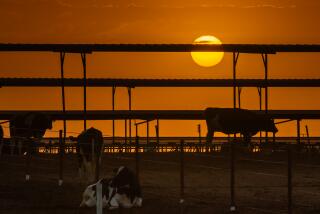Fears Take Bite Out of the Sale of Beef
- Share via
CHIBA, Japan — In a refrigerated room on the outskirts of Tokyo, three men tear open a cardboard box to expose the building block of a hamburger empire: A frozen slab of beef.
Workers at this McDonald’s plant operate the massive grinding machines that turn the slabs into hamburger patties, making it a vital link in the company’s domestic web of suppliers.
But since Japan’s first case of mad-cow disease was confirmed in September, anything involving beef has become suspect in the minds of many consumers. Despite the fact that the beef here is imported from mad cow disease-free Australia and certified as safe, the scare continues to spread.
“The plant’s sales are down--our entire restaurant chain’s sales are down--because the image of beef here has gone sour,” said McDonald’s spokesman Kenji Kaniya.
The first case of the deadly disease was confirmed on a farm just outside Tokyo. In November, health officials confirmed two more cases. In December, preliminary tests at a meat-processing center in western Japan revealed a suspected fourth diseased Holstein.
Mad cow disease, known formally as bovine spongiform encephalopathy, or BSE, is believed to be caused by proteins gone awry. Called prions, the proteins bore holes into the brain.
Scientists aren’t sure how the disease is contracted, but suspect feed made of recycled cow parts. Japanese media have speculated that the cause lies in milk supplements or other cattle food imported from Europe, where most of the 180,000 cases worldwide have been recorded.
In Japan--the only country in Asia with mad cow--the outbreak still appears to be limited.
But officials have bungled efforts to put the public at ease. After offering assurances about home-grown beef, health officials found more diseased cows.
“Don’t be surprised. There is still more to come,” Tsutomu Takebe said days after the third case was confirmed Nov. 30.
The illness, which has ravaged Europe’s cattle industry, is thought to cause the fatal variant Creutzfeldt-Jakob disease in humans who eat infected meat, though experts still aren’t certain there is a link. It has killed more than 100 people, nearly all of them in Britain. None here has CJD.
Promising drastic measures, Japan’s agriculture ministry has said it will slaughter 5,129 cattle that may have eaten infected feed, destroy 14,300 tons of beef kept in storage nationwide, and tighten screening of animals headed to the marketplace. The plan to kill the animals would be the first time for the ministry to eliminate some of the nation’s 4.5 million cows.
Japan’s beef industry already faces billions of yen--or tens of millions of dollars--in losses.
Domestic farms produced $3.58 billion worth of beef in 2000, some of it for export. Japanese consumers ate nearly 1.1 million tons of beef in 1999, with about a third coming from domestic farms and nearly all of the remaining two-thirds coming from Australia and the United States.
But this year’s figures may fall far short.
“The public is panicking. At this point, it’s difficult to estimate the damage. But with prices so low, industry profits are obviously way down, for some by as much as 80%,” said Japan Cattle Industry Cooperative spokesman Tokuhiro Miwa.
The agriculture ministry has pledged $1.23 billion in assistance.
Meanwhile, restaurant chain Yoshinoya D&C;, known for its cheap rice and teriyaki beef meals, has taken out ads to stress its beef comes primarily from the United States. Others, including Korean barbecue shops, are following suit.
For McDonald’s, the last couple of months have been painful.
Until the mad cow cases surfaced, the company had enjoyed rising sales and captured 65% of Japan’s fast-food burger market with a recession-busting menu of half-price hamburgers and cheeseburgers on weekdays.
Despite ads featuring its Australian beef patties, the burger chain saw sales on a same-store basis--those open at least a year--fall 17.6% in October, from the same month a year earlier, and 17.2% in November, said spokesman Kaniya.
Total sales, including those from newly launched restaurants, were down 12.1% in October and 12.0% in November, he said.
To Kaniya, those numbers aren’t that bad--even a bit comforting. Domestic producers are probably suffering more, he said.
“Our figures seem to indicate a slight rebound. We hope this is a sign that the worst has passed,” he said.
*
On the Net:
Meat and Livestock Australia: www.mla.com.au
U.S. Meat Export Federation: www.usmef.org
More to Read
Sign up for Essential California
The most important California stories and recommendations in your inbox every morning.
You may occasionally receive promotional content from the Los Angeles Times.









